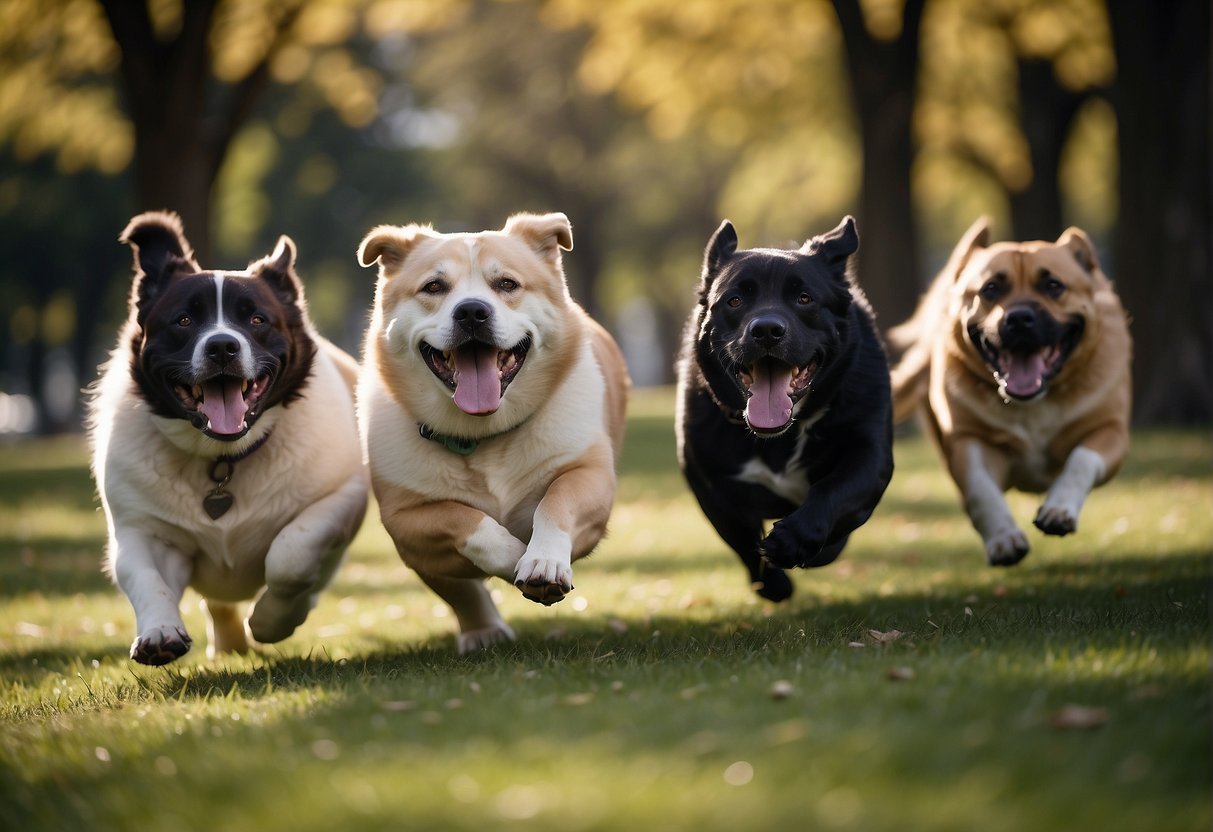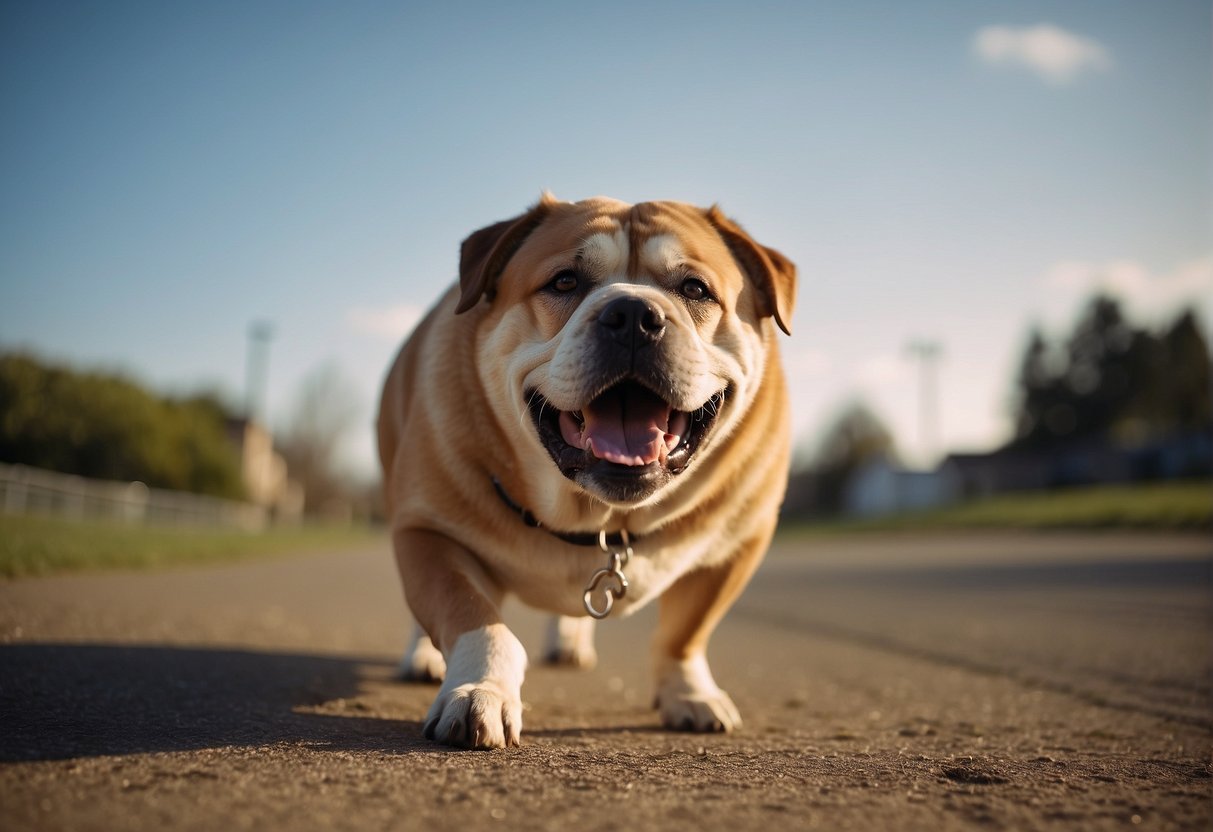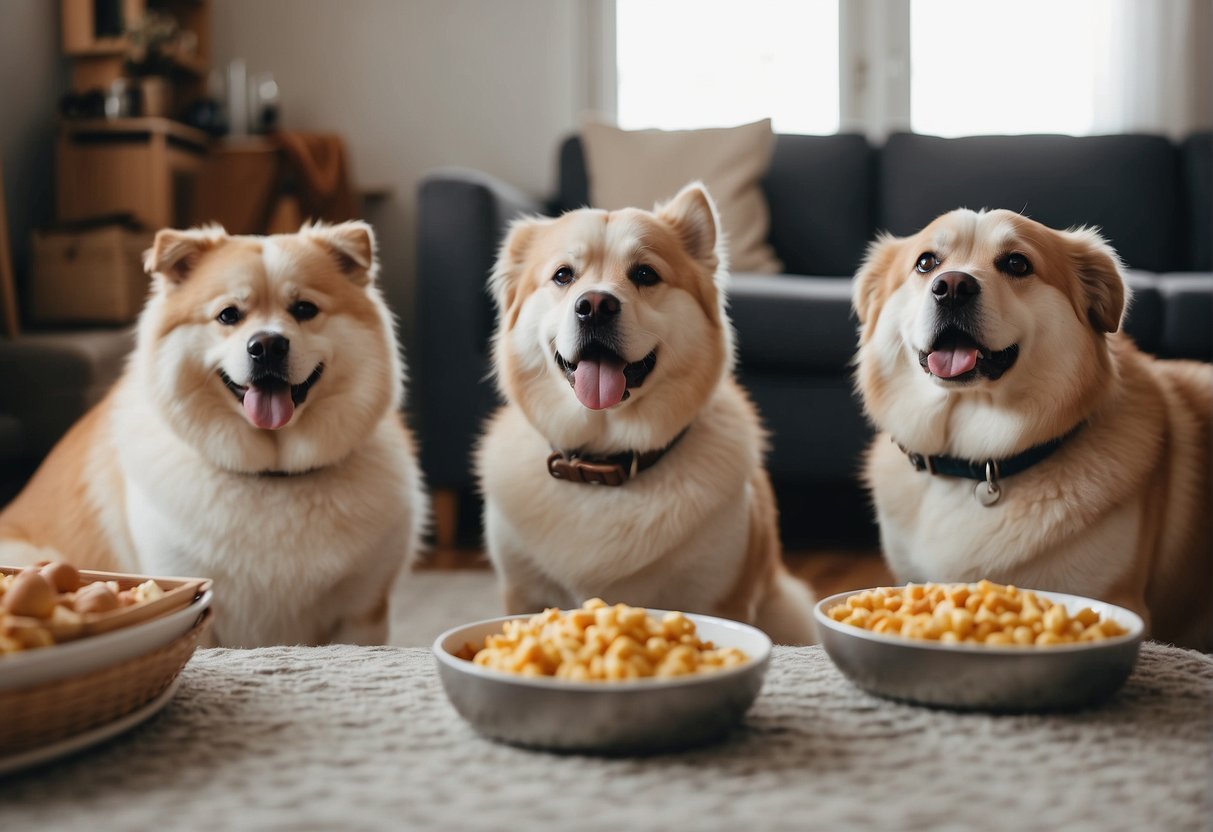Obesity in dogs is an increasingly common issue, with many pets experiencing the negative effects of carrying excess weight. Recognizing the signs of obesity in your dog is essential, as it can lead to a variety of health problems.
As a responsible pet owner, understanding how to assess your dog’s weight and knowing the steps you can take to ensure they achieve a healthier lifestyle is imperative.
Maintaining your dog’s health involves a blend of proper diet, adequate exercise, and regular veterinary check-ups. By incorporating love and care into their routine, you can help your beloved companion live a longer, happier life.

Key Takeaways
- Early detection and management: of canine obesity prevent health issues like diabetes and arthritis, improving longevity and quality of life.
- Diet and Exercise Are Key: A balanced diet and consistent exercise are critical for maintaining a healthy weight in dogs. Proper portion control and engaging physical activities help prevent obesity.
- Regular Vet Check-Ups: Veterinary consultations play a significant role in weight management, offering tailored advice on diet and exercise tailored to the dog’s specific needs.
- Behavioral Training Supports Weight Loss: Addressing begging behavior and employing reward-based training without overfeeding are effective strategies in managing a dog’s weight.
- A holistic strategy: combining diet, exercise, veterinary care, and behavioral training promotes a healthier, happier lifestyle for dogs.
Understanding Canine Obesity

Obesity in dogs, much like in humans, is a health condition marked by an excess of body fat. If your dog is fat, it doesn’t just affect their overall appearance, but it can have significant health implications.
Importance lies in recognizing the distinction between an overweight dog, which refers to one who is 10-20% above their ideal body weight, and an obese dog, which is defined as weighing 20% or more above what is considered healthy.
How to Tell if Your Dog is Overweight or Obese:
- Check their body shape: An overweight dog may have less noticeable waistlines and no discernible abdominal tuck.
- Feel their ribs: If you can’t easily feel your dog’s ribs without pressing hard, they might have excess weight.
The American Kennel Club says the following:
“Overweight and obese dogs are typically inactive and spend a lot of time scarfing down their food. If you notice that your dog has become a couch potato, has trouble walking, exhibits trouble breathing when walking, and generally appears to have trouble moving about, they might be fat. Also, if you free-choice feed your dog throughout the day, this can encourage obesity.”
Recognizing that your dog is getting overweight early on is important, since canine obesity can contribute to a variety of health problems, including diabetes, joint issues, and decreased life expectancy.
Here are a few potential causes for your dog gaining excess weight:
- Overfeeding: Providing too many calories, regardless of a food’s quality.
- Lack of exercise: Dogs need regular physical activity to burn calories.
- Medical conditions: Certain diseases can predispose dogs to weight gain.
Effective management combines dietary changes and increased physical activity. Remember, gradual weight loss in overweight dogs is safer and more sustainable than rapid weight loss.
Veterinarians often use a body condition scoring system to assess if your dog is overweight or obese. The system ranges from 1 (emaciated) to 9 (obese), with an ideal score around 4 or 5, depending on the breed and age.
Health Risks Associated With Excess Weight

Here’s a table that presents the dangers of dog obesity very clearly:
| Health Issue | Description | Impact |
|---|---|---|
| Heart Disease | Excess weight forces the heart to work harder, potentially leading to congestive heart failure. | Compromised heart function |
| Arthritis | Extra weight puts unrelenting stress on joints, causing early onset and worsening arthritis. | Decreased mobility and quality of life |
| Osteoarthritis | Significant decreases in physical activity due to osteoarthritis can result from carrying too much weight. | Reduced mobility and increased pain |
| Diabetes | Excess fat can cause insulin resistance, making dogs more susceptible to diabetes. | Requires lifelong management |
| High Blood Pressure | Unnecessary weight can drive up blood pressure, intensifying heart and kidney problems. | Increased risk of organ damage |
| Cancer | Obesity has been associated with an increased risk of certain cancers. | Potentially life-threatening |
| Other Heart Problems | Excess fat strains the entire circulatory system, leading to various heart problems. | Reduced cardiovascular health |
| Respiratory Difficulties | Overweight dogs often have little stamina for exercise, making breathing difficulties more likely. | Decreased respiratory function |
Managing your dog’s weight through proper diet and exercise can help reduce the severity and risk of these health issues, improving their overall quality of life.
Even subtle weight gain can escalate quickly and lead to chronic conditions that diminish the quality and length of your pupper’s life.
Diet and Nutrition

Assessing Dog Food Quality
When selecting a dog food, consider both the calorie content and the nutritional value. High-quality dog foods provide the nutrients your dog needs without unnecessary fillers.
Look for foods with identifiable animal protein sources as the first ingredient and avoid those with excessive caloric density, as this can lead to weight gain even in small portions.
Your vet can advise you on a meal or weight loss plan for your doggo.
Understanding Caloric Needs
Your dog’s caloric needs depend on their size, age, and activity level. Spayed or neutered dogs typically require fewer calories.
To maintain an ideal weight, offer meals and healthy treats with an eye on portion control. Avoid frequent high-calorie snacks or table scraps, which can quickly lead to weight gain.
Adjust your dog’s calorie intake according to their weight goals and activity levels.
Exercise and Physical Activity

Regular exercise is vital for your dog’s health, assisting in weight control, improving mood, and decreasing the risk of obesity. Establishing a daily routine and incorporating a variety of physical activities can contribute significantly to your dog’s overall well-being.
Daily Exercise Routines
To ensure your dog gets the necessary amount of exercise, commit to a daily routine that includes at least 30 minutes to an hour of walking. This can be split into two sessions if your schedule is tight.
Maintaining this routine helps your dog develop better mobility, stamina, and muscle tone.
A dog treadmill on low settings could help possibly help your dog get moving again! Remember to get them used to a bit of exercise, and increase it slowly to not shock their system.
Fun and Engaging Activities
Beyond walking, engage your dog in activities that both entertain and provide physical benefits. Playing fetch is a classic that stimulates the mind and increases agility.
If you have access to a safe water body, swimming can be an excellent low-impact exercise, particularly beneficial for dogs with joint issues, as it enhances strength and endurance.
Veterinary Care and Regular Check-Ups

Veterinary Care is crucial in managing your dog’s weight and ensuring overall health. Regular check-ups with your veterinarian provide an opportunity to monitor your dog’s weight and assess for any health conditions that could be contributing to weight gain, such as hypothyroidism.
Routine Visits allow the vet to:
- Assess Body Condition: Check for any changes in body shape or weight.
- Monitor Health Status: Keep track of any developments that may affect your dog’s weight, like a sluggish metabolism, which may be a sign of hypothyroidism.
- Create a Health Plan: Develop or adjust dietary plans and exercise regimes based on your dog’s specific needs.
Your vet is your partner in keeping your dog healthy. Their expertise can help you navigate the complexities of your dog’s nutritional needs and maintain an ideal weight, which is essential for a vibrant, active lifestyle.
Developing a Weight Management Plan

When your dog is carrying extra pounds, creating an effective weight management plan is crucial. This plan involves gradual weight loss to reach and maintain a healthy weight without compromising your dog’s health.
🎯 Step 1: Set the Goal
- Work with your vet to determine your dog’s ideal body weight
- Consider factors like breed, age, and physical build
🥫 Step 2: Choose the Right Food
- Select a nutrient-rich, low-calorie diet formulated for weight loss
- Ensure the food meets your dog’s specific nutritional needs
🧮 Step 3: Calculate Caloric Needs
- Use your dog’s ideal weight to determine daily caloric requirements
- Aim for a calorie deficit to promote weight loss
🕰️ Step 4: Establish a Feeding Routine
- Divide the daily calorie intake into two or three meals
- Avoid free-feeding to help control portions
🏃♂️ Step 5: Incorporate Exercise
- Include regular exercise in your dog’s daily routine
- Gradually increase intensity to prevent injury
📈 Step 6: Monitor and Adjust
- Weigh your dog monthly to track progress
- Adjust diet and exercise as needed to ensure consistent weight loss
Remember, patience and consistency are key to helping your furry friend achieve a healthy weight!
Remember, the goal is a gradual weight loss to avoid stress on your dog’s body, leading to weight maintenance and overall health improvement. Always work with your vet to tailor the plan to your dog’s specific needs.
Support and Resources

When managing your dog’s weight, please understand that you’re not alone in this journey. Various organizations and tools are available to assist you in assessing your pet’s body condition and taking the right steps to improve their health.
Association for Pet Obesity Prevention: This organization is a valuable resource for pet owners. By visiting their website, you can find comprehensive guides and the latest research to inform you about pet obesity and how to prevent it.
Body Condition Score (BCS): Learning to accurately assess your dog’s body condition is fundamental. A BCS chart provides a visual aid to help you determine if your dog is underweight, ideal, overweight, or obese.
| Body Condition Score | Description |
|---|---|
| 1-3 | Underweight |
| 4-5 | Ideal |
| 6-9 | Overweight to Obese |
Veterinary Care: Your veterinarian is a key resource in your dog’s weight management. They can offer a tailored diet and exercise plan, monitor progress, and address any medical issues contributing to weight gain.
Initiatives and Programs: Look for local and national initiatives promoting pet health. These may include free nutrition seminars, weight loss programs, or exercise initiatives designed to keep your pet in top shape.
Behavioral Changes and Training

When your dog is overweight, modifying behaviors related to feeding is a must. Training your furry friend requires a balance between reinforcing positive behavior and ensuring you’re not contributing to the weight problem with excessive treats.
Dealing With Begging Behavior
Identify Triggers: Take note of what prompts your dog to beg. Is it during your meal times, or when they see you with a snack? Recognizing these triggers can help you anticipate and manage begging behavior.
Set Boundaries: Be consistent in not giving in to begging. Feeding your dog from the table reinforces the behavior. It’s important for all household members to adhere to this rule to avoid confusion for your dog.
Reward-Based Training Without Overfeeding
Use Healthy Treats: Opt for low-calorie treats or even parts of your dog’s daily kibble ration to avoid extra calories. Find treats that support weight management and use them sparingly.
Non-Food Rewards: Reinforce positive behavior with love and attention rather than treats. A pet, praise, or play session can be just as effective as a food reward.
Measure Treats: If you choose to use treats for training, incorporate them into your dog’s daily calorie allotment. This will prevent overfeeding and help maintain a healthy weight.
Conclusion

When your dog achieves a healthy weight, the benefits are immediately noticeable. Your dog will likely have more energy and joy, engaging more in play and activities.
Take the inspiration from a Lab mix named Mindy. Mindy went from 80 pounds to a goal weight of 55 pounds, mirroring the enthusiasm of a much younger pup. Some suggestions from the owner was:
“Cut down on treats. Using veggies as a substitute helps. Get out there and get more exercise together and if you’ve got the time, cook for them or at least replace some of the kibble with real food. Every step you can take toward feeding real food is a plus.”
Weight loss in dogs doesn’t just enhance the quality of their day-to-day life—it can also extend their life expectancy.
It’s essential to remember that while it can be a challenge, the process of helping your dog lose weight is a deeply rewarding journey.
With the right diet, exercise, and veterinary guidance, your dog can achieve and maintain a healthy weight, leading to a happier and potentially longer life.



